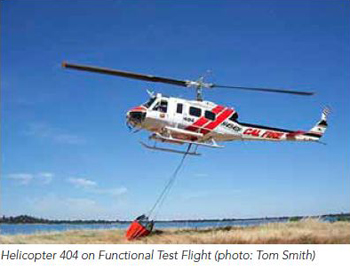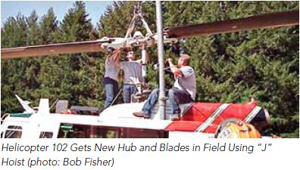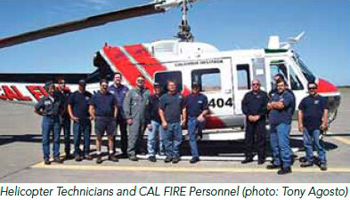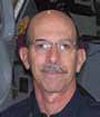
CAL FIRE – Helicopters Helping to Meet the Public Need

Putting the “You” in Utility
I had never given public use aviation much thought at the start of my career, because nobody ever mentioned it as a potential job avenue. My public use education began when I came the base mechanic for a company that had a contract to maintain a California Highway Patrol helicopter. Since then I have had the opportunity to work in almost all aspects of public and civil utility helicopter maintenance, including fire suppression, law enforcement/SAR, EMS, agricultural applications, seismic exploration and construction lift work. I urge any newly-minted A&Ps to think about this segment of aviation if they want a challenging career that takes them out of the hangar from time to time. For the purposes of this article, I’ll stick to the public use agencies, but I would be remiss if I didn’t point out the many private operators who perform these functions as private enterprises contracting to public agencies.
A Public (Use) Example
I work for CAL FIRE, which is California’s Department of Forestry and Fire Protection (formerly referred to as the CDF). CAL FIRE’s fleet of fire fighting helicopters consists of 11 UH-1H “Super Hueys.” These aircraft are on a permanent loan from the United States Department of Agriculture, through the United States Forest Service (USFS). They are part of the Federal Excess Personal Property program (FEPP). The helicopters were given to the State to use in support of the aviation section of the world’s largest fire department and fire fighting air force (more than 50 aircraft). I invite you to visit the CAL FIRE aviation page at: www.fire.ca.gov/fire_protection/fire_protection_air_program.php.
CAL FIRE began operating its own helicopters in 1981 with FEPP UH-1F models. In the mid-1980s, CAL FIRE switched to the UH-1H, and (before Bell did it) modified these aircraft to a configuration almost identical to the Bell Helicopter Huey II. This model is now being sold by Bell and used by the U.S. State Department, Customs and Border Protection and other public agencies. The UH-1H continues to evolve, not only through the efforts of CAL FIRE and Bell Helicopter, but through the efforts of many private companies that provide services and multiple aftermarket improvements. CAL FIRE has made more than 60 major and minor modifications to these aircraft. The first conversion was completed by Big Valley Aviation in Stockton, CA, and subsequent conversions were performed by San Joaquin Helicopters of Delano, CA. CAL FIRE continues to improve these aircraft with modifications that are available now, and look at other improvements that are in the pipeline that add to the performance and reliability of this airframe. This helicopter is of superb design for fast initial attack on wildland or urban fires, delivering a crew of eight or nine fire fighters directly to the fire front and then going to work with the bucket or snorkel tank. The modifications make it especially well suited to this task.

CAL FIRE modified the FEPP UH-1H helicopters by installing the T53-L-703 engine from the Bell Huey Cobra, Cobra main transmission, tail booms modified to the Bell 205A-1/212 configuration, Bell 212 main rotor and tractor tail rotor systems, 212 lift beam, 212 tail rotor driveshaft hanger bearing assemblies, and many other product improvements. The oldest airframe we have was built in 1969. The newest was built in 1972. Notably, much of this work was performed with the cooperation of Bell Helicopter.
Some of these changes, for example installation of the Bell 212 main rotor system, were made by purchasing STCs (supplemental type certificates); others were engineered by CAL FIRE. Access to FEPP parts and being able to purchase parts from the U.S. Defense Logistics Agency helped to make this possible. The helicopters, as well as 23 Grumman S-2T tankers and 14 North American OV-10A airplanes CAL FIRE flies, are not type certificated (TC’d). Make no mistake — public use operators may also fly type-certificated aircraft. It is the agency and the mission that determines whether or not an aircraft is public use, not the aircraft. Do not confuse military use with public use. The military services are authorized to do what they do under yet a different set of rules. The military may fly media rides and movie stars; public use agencies may not.
To be classified as public use, the aircraft must:
1. Be operated by or on contract to a federal, state or local government for exclusive use of at least 90 days (for federal agencies there is no 90 day requirement).
2. Not be used for transport of people or cargo for compensation or hire.
3. Be used for a governmental mission; any personnel on board must be “mission essential” (i.e. mechanics are OK, fire fighters are OK, the media are not OK).
An aircraft, if it is type certificated, may be public use in the morning and civil use in the afternoon, if it can be shown to have been maintained to the standards required for civil certification (i.e., maintained to its type certificate and in airworthy condition). This is one reason why, for a TC’d aircraft in public use, it is very important to adhere to an FAA-approved inspection program (commonly the manufacturer’s program), and have all modifications performed and documented per FAA guidelines, even though this is not required. A standard or transport category helicopter, when operated as public use, may do anything the non-TC’d aircraft may do, in addition to moving in and out of public use operations. Non-TC’d aircraft may never be used for civil operations (i.e., flown for hire or with nonessential passengers). During the time the aircraft is in public use, it makes no difference if it is type certificated or not as far as maintenance requirements. However, in all cases the agency should have its own guidelines for a maintenance program.
If the aircraft is type certificated and the agency wants to sell it to a civil operator, the airworthiness certificate becomes invalid if it has not been maintained to all civil aircraft standards. It may be brought back to those standards through proper documentation and/or the use of a Designated Airworthiness Representative (DAR). A common misconception is that a public use aircraft has to have the airworthiness certificate removed. The airworthiness certificate must only be removed from the aircraft and surrendered if it is modified to the extent that it cannot be reasonably returned to its certificated configuration.
Many ex-military helicopters have been put into the restricted category. They must abide by restrictions such as no passengers other than crew, not flying over populated areas or other restrictions that may apply to their restricted airworthiness certificate. Public use aircraft are not limited in this manner. For example, public use aircraft may perform class D external loads (that is, live people on hoists or short-haul ropes). For a civil operator to do that, according to part 133 (and the external load certificate they would have to have), it would require a transport category (FAR part 29) aircraft certified to category A standards. Public use operators can do this with single-engine aircraft that obviously do not meet this specification. This is just a glimpse of some of the differences between public use and civil registered aircraft.
Rules and Guidelines
From a maintenance perspective, public use operators are governed differently from civil aircraft operators. Public use aviation is not regulated by FAR Parts 43, 61, 21, 27, 135, 145 and sections of Part 91. CAL FIRE does maintain an FAR Part 145 repair station certificate because it provides an excellent procedural framework. Only our type-certificated aircraft are listed on the Operations Specifications, but we run the entire Aviation Management Unit (AMU) as if it were a Part 145 facility. We operate 50 aircraft that are from the FEPP program and are not covered by civilian type certificates. It should be added that CAL FIRE personnel Bob Fisher and Cecil Gill (both retired) guided this program from the start and provided a framework for maintenance and operation of ex-military, non-type certificated helicopters that has resulted in more than 60,000 flight hours without a serious injury.
CAL FIRE has developed its own rules and guidelines that mirror FAA rules in most cases. The maintenance and quality assurance functions of the program are run by a contractor (currently DynCorp International). Purchasing and logistics are also supplied by a contractor (Logistic Specialties Inc.). The CAL FIRE AMU manages maintenance and operation of the aircraft.
Let’s look at how public use aviation is different from what many of us are used to. Since public use agencies are not regulated by the same constraints as the civil sector, many aspects of how they operate are left up to the aircraft managers, and no formal FAA approval is required. Normal FAA surveillance is limited to confirming that public agencies continue to qualify for public use status. The FAA has always been available for advisory purposes. A good source of information is FAA AC 00-1.1. I would also recommend the Airborne Law Enforcement Association as an excellent resource for public use issues.
Our non-TC’d aircraft have no FAA-approved maintenance or flight manuals (CAL FIRE writes its own aircraft flight manuals). STCs do not really apply because there is no TC to supplement. Airworthiness directives apply only to FAA certificated items. “Wait,” you say, “there are 11 different restricted category type certificates for the UH-1H, and there are ADs that apply to them.” This is true, but our helicopters do not conform to any of those type certificates. Our pilots are not legally required to have pilot certificates or FAA flight reviews, and our mechanics are not required to have A&P certificates.
With all of this leeway, we take great pains not to abuse the lack of requirements. We are well aware that many of the assemblies and parts on our helicopters are the same as those on commercial equivalents, to which the ADs/SBs and other FAA-approved instructions for continued airworthiness (ICAs) do apply. We perform our work to the specifications of the manufacturers, Army technical manuals, STC holders and FAA regulations. CAL FIRE requires that our helicopter pilots are appropriately rated and get annual recurrent training that includes full touch-down auto rotations. All but a very few of the mechanics have A&P certificates and many maintain inspection authorization.
The Same But Different
It gets even more interesting. Our helicopters came with their military technical manuals. The manufacturer of the UH-1H didn’t write the manuals and doesn’t maintain them. For organizations that may not be familiar with where these documents come from, it can be difficult getting set up with the latest Army publications. The documents used to be available through the NTIS (National Technical Information Service), but they are no longer distributed that way. The Army still has some stock of manuals and updates, but these are only available to public use operators, and when the supply is gone there will be no reason to print more.
The only other sources for these documents are private companies, of which there are several,that are in business primarily to sell these documents. Check to be sure you are getting the latest revision if you use these sources. To the best of my knowledge, there is nobody that supplies any sort of revision service for the existing revisions. Because all of the single engine UH-1 helicopters have been taken out of Army service, the Army has stopped issuing new bulletins or revisions to their Huey publications. The Army never imagined these helicopters would be around for 40 years, and it wasn’t intended that these aircraft be used outside of the military.
We have written our own flight manual and inspection program based on a combination of military and commercial documents. Because the CAL FIRE helicopters are a mix of military and commercial configurations, we maintain current Army manuals for the UH-1H, Bell manuals for the 205 and 212, Honeywell commercial manuals for the T53-L-703 engine, as well as the military TM for the -703 and the T53-L-13B that came in the UH-1H. A shelf full of instructions for continued airworthiness (ICAs) and a host of Army bulletins supplement these manuals. The army has Aviation Safety Action Messages (ASAM), Safety of Flight (SOF), Aviation Maintenance Action Messages (AMAM) and Aviation Maintenance Information Messages (AMIM). These are currently available at the Army Electronic Product Support (AEPS) Web site. You must be approved by the U.S. government to gain access to this site. The technical manuals and Depot Maintenance Work Requirements (DMWR) are not available on the AEPS site.
Since there is no FAA-approved data on non-TC’d aircraft, the FAA will not allow a repair station to approve them for return to service using either the repair station certificate, A&P number or a statement that it is “airworthy” (they prefer “in condition for safe flight”). FAA 8130-3 forms are not always part of the records for an aircraft that may have many military parts that have no commercial equivalent. It is questionable if an FAA 8130-3 form should be used for parts or assemblies that have no FAA certification basis. A maintenance release or certificate of conformance takes the place of the 8130-3 form in many cases.
For the UH-1H and the OH-58, one can use the Army phased inspection program right out of the Army publications (this is what many of the restricted category TC holders also require), or thanks to the Department of General Services Interagency Committee for Aviation Policy (ICAP), there have been inspection programs written for public use operators. These are written more like the commercial inspection programs than the Army programs. The ICAP programs are available for no charge through the U.S. Department of General Services. A restricted category helicopter could not use this program unless it was called out in the TC, or became FAA approved through the operator. The point is that public use operators may choose one of these programs or write their own program, with no input or approval from the FAA. The CAL FIRE inspection program covers from a 25-hour inspection through a 10-year IRAN (inspect and repair as necessary) inspection that includes complete disassembly and new paint. The latter takes about seven months. We sign off our inspections with “in condition for safe flight” and an employee number and name.
We have and continue to use the services of DERs (Designated Engineering Representatives) when we do not have engineering data for a proposed modification. In some cases, CAL FIRE will purchase an STC for a modification if it is applicable and available, even though we are installing it on a non- TC’d airframe. Each aircraft has compliance lists for ADs and SBs for restricted category UH-1Hs, the Bell models 205A-1, the 212, 210 (the type-certificated version of the Huey II) and those that apply to STC’d parts that we have used, the commercial equivalent of the military engine and Army maintenance and safety bulletins. We also comply with ADs that affect installed appliances. When it comes to airworthiness limitations schedules, we use a mix of commercial, military and our own retirement times (the latter only for items that have no time established, but through operational experience it has been determined to be a good thing to do); likewise for overhaul intervals. We never change a retirement time or overhaul interval unless it is a self-imposed limit. Ex-military aircraft that have undergone type certification to the restricted category may have cycle life limits placed on parts that were not being tracked by the military. Engine cycle counts may have to be determined from engine flight hours because the military didn’t use cycles in some cases for part retirement purposes. The problems associated with bogus parts are amplified in the ex-military environment and extra caution in purchasing parts must be used. If they are available, purchasing commercial parts from the manufacturer often eliminates this potential problem.
 Our mechanics are fortunate in that we work on one model of aircraft. Standardization is a real lynchpin of our program and that helps when things break. We have a lead mechanic and a QA inspector for the 10 mechanics on the helicopter side of the house. Working in our or any other public use agency hangar is not any different from working in any repair station environment, but it gets to be different when we have to go on the road. Mechanics who work on utility helicopters know that the machine can end up in inconvenient locations. The worst-case scenario for repair would be if an aircraft needed to be slung out by another helicopter. We have never had to do this. We have had to change engines and main rotor blades in the field (see photos). The UH-1 was provided with a “J” hoist that can be carried in the helicopter, assembled at the site, plugs into the fuselage and may be used to change a main rotor system or engine. It is straightforward for an engine change, but doing a main rotor hub and blade removal or installation can be difficult compared to using our remote controlled electric hoist in the hangar (the 212 rotor system is about 50 pounds heavier than a standard UH-1H hub and blade assembly and it is near the load limit of the “J” hoist).
Our mechanics are fortunate in that we work on one model of aircraft. Standardization is a real lynchpin of our program and that helps when things break. We have a lead mechanic and a QA inspector for the 10 mechanics on the helicopter side of the house. Working in our or any other public use agency hangar is not any different from working in any repair station environment, but it gets to be different when we have to go on the road. Mechanics who work on utility helicopters know that the machine can end up in inconvenient locations. The worst-case scenario for repair would be if an aircraft needed to be slung out by another helicopter. We have never had to do this. We have had to change engines and main rotor blades in the field (see photos). The UH-1 was provided with a “J” hoist that can be carried in the helicopter, assembled at the site, plugs into the fuselage and may be used to change a main rotor system or engine. It is straightforward for an engine change, but doing a main rotor hub and blade removal or installation can be difficult compared to using our remote controlled electric hoist in the hangar (the 212 rotor system is about 50 pounds heavier than a standard UH-1H hub and blade assembly and it is near the load limit of the “J” hoist).
Where Maintenance and Operation Mix
A certificated aircraft may be ferried to a repair facility if it becomes unairworthy for reasons that do not seriously affect the safety of flight. The “ferry permit” is a special airworthiness certificate that is issued under FAR 21. Since our aircraft are not TC’d, this does not apply to us. We go through the same procedure to allow a ferry flight to be made, but do not need FAA approval to do it. This is an enormous benefit when there are fires burning and one of our aircraft must be flown to a maintenance base. We make frequent use of our cell phones, digital cameras and e-mail. In a matter of minutes we can look at something a pilot has found, regardless of where the aircraft is. Sometimes digital images are even better than seeing something in person due to the ability to magnify the image. We do operate with an MEL, and it works just the way a 135 operator’s MEL works, except it cannot be FAA approved.

It is not uncommon for our mechanics to work alone. As with any aviation operation where field work is performed, special care must be taken and the second set of eyes is often the pilot on duty. Critical items are required to be inspected, much as a FAR Part 135 certificate holder would be required to specify. An inspector will go to the field if the repair job is large enough to warrant it. CAL FIRE has refined the spares traveling kit to the point that when a mechanic goes to the helicopter’s location for 50-hour inspections (the pilots perform the 25-hour), we rarely get stuck without a needed part. CAL FIRE does not have “base” mechanics for the nine helitack bases spread out across the state; we send mechanics to the helicopter for scheduled and unscheduled maintenance. It is a further testament to the “Super Huey” that it can fly an average of 300 hours per year without having a mechanic on site. All of the helicopters come back to the hangar at McClellan, CA for “winter maintenance.” We perform the necessary maintenance during this cycle in an effort to avoid having to bring a helicopter in for major scheduled items (such as a transmission change) during that part of the year when fires are likely (which is roughly from May through late October). We also perform any major upgrades during that time. Even during fire season, scheduled inspections more extensive than the 50-hour are performed at our main facility. We will fly a spare helicopter to the base and return with the helicopter that needs a 100-hour inspection.
Mechanics that work for a company that has a DOI (Department of the Interior) or USFS “exclusive use” or “call when needed” contract have to be “carded” by an aviation maintenance inspector from one of these agencies. The carding requirements vary somewhat, but are based on experience with the make, model and time working in unsupervised environments. The cards are only good for the period specified, and it is often a yearly process to be carded, as it is for pilots and aircraft. A mechanic cannot be carded unless they actually have a position with a company that has a contract. The goal is to ensure that only qualified mechanics are in the field with machines that are on contract. When an employment ad says “must meet USFS or DOI carding requirements” or “must be cardable,” it means you should have the experience required on the make and model being put on contract and have the ability to work with pilots in the fire-fighting environment, unsupervised for long periods of time.
Hopefully some of the misunderstandings about maintenance issues and some operational issues have been made clear, (or at least less muddy). The National Association of State Foresters has provided a new set of standards for “cooperator agencies” (i.e., fire departments, sheriffs departments, etc.) that are flying non-TC’d aircraft on federal fires. These cooperator standards are specific to both general and airframe model. Starting next year, these agencies will need to meet these standards in order to be “carded” to work on federal fires. This is strictly a safety issue and it is an attempt to standardize the condition of the government controlled fleet of aircraft that have no FAA type certificates.
Jon Robbins
 Jon Robbins has been an A&P mechanic for 31 years. He holds IA and private pilot and instrument airplane ratings. He supervises the helicopter maintenance program at CAL FIRE. Send e-mail to jon.robbins@fire.ca.gov.
Jon Robbins has been an A&P mechanic for 31 years. He holds IA and private pilot and instrument airplane ratings. He supervises the helicopter maintenance program at CAL FIRE. Send e-mail to jon.robbins@fire.ca.gov.
